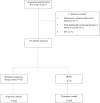High flow nasal oxygen therapy to avoid invasive mechanical ventilation in SARS-CoV-2 pneumonia: a retrospective study
- PMID: 33638752
- PMCID: PMC7910764
- DOI: 10.1186/s13613-021-00825-5
High flow nasal oxygen therapy to avoid invasive mechanical ventilation in SARS-CoV-2 pneumonia: a retrospective study
Abstract
Background: The efficacy of high flow nasal canula oxygen therapy (HFNO) to prevent invasive mechanical ventilation (IMV) is not well established in severe coronavirus disease 2019 (COVID-19). The aim of this study was to compare the risk of IMV between two strategies of oxygenation (conventional oxygenation and HFNO) in critically ill COVID 19 patients.
Methods: This was a bicenter retrospective study which took place in two intensive care units (ICU) of tertiary hospitals in the Paris region from March 11, to May 3, 2020. We enrolled consecutive patients hospitalized for COVID-19 and acute respiratory failure (ARF) who did not receive IMV at ICU admission. The primary outcome was the rate of IMV after ICU admission. Secondary outcomes were death at day 28 and day 60, length of ICU stay and ventilator-free days at day 28. Data from the HFNO group were compared with those from the standard oxygen therapy (SOT) group using weighted propensity score.
Results: Among 138 patients who met the inclusion criteria, 62 (45%) were treated with SOT alone, and 76 (55%) with HFNO. In HFNO group, 39/76 (51%) patients received IMV and 46/62 (74%) in SOT group (OR 0.37 [95% CI, 0.18-0.76] p = 0.007). After weighted propensity score, HFNO was still associated with a lower rate of IMV (OR 0.31 [95% CI, 0.14-0.66] p = 0.002). Length of ICU stay and mortality at day 28 and day 60 did not significantly differ between HFNO and SOT groups after weighted propensity score. Ventilator-free days at days 28 was higher in HNFO group (21 days vs 10 days, p = 0.005). In the HFNO group, predictive factors associated with IMV were SAPS2 score (OR 1.13 [95%CI, 1.06-1.20] p = 0.0002) and ROX index > 4.88 (OR 0.23 [95%CI, 0.008-0.64] p = 0.006).
Conclusions: High flow nasal canula oxygen for ARF due to COVID-19 is associated with a lower rate of invasive mechanical ventilation.
Keywords: Acute respiratory failure; COVID-19; High flow nasal canula; Intensive care unit.
Conflict of interest statement
JRZ reports personal fees from Pfizer, personal fees from Correvio, personal fees from Eumedica, personal fees from Merck Sharp and Dohme, outside the submitted work. NB, OM, MB, VL, NE, PK, YTL, GVDM, JO, MS, MG, AW, PA, SG ang YC report no conflict of interest.
Figures
Similar articles
-
Comparison between high-flow nasal oxygen (HFNO) alternated with non-invasive ventilation (NIV) and HFNO and NIV alone in patients with COVID-19: a retrospective cohort study.Eur J Med Res. 2024 Apr 22;29(1):248. doi: 10.1186/s40001-024-01826-3. Eur J Med Res. 2024. PMID: 38649940 Free PMC article.
-
Endotracheal intubation rate is lower with additional face-mask noninvasive ventilation for critically-ill SARS-CoV-2 patients requiring high-flow nasal oxygen: a retrospective bicentric cohort with propensity score analysis.Minerva Anestesiol. 2022 Jul-Aug;88(7-8):580-587. doi: 10.23736/S0375-9393.22.16094-3. Epub 2022 Feb 22. Minerva Anestesiol. 2022. PMID: 35191641
-
The Predictive Values of Respiratory Rate Oxygenation Index and Chest Computed Tomography Severity Score for High-Flow Nasal Oxygen Failure in Critically Ill Patients with Coronavirus Disease-2019.Balkan Med J. 2022 Mar 14;39(2):140-147. doi: 10.4274/balkanmedj.galenos.2021.2021-7-32. Balkan Med J. 2022. PMID: 35330565 Free PMC article.
-
High-flow nasal oxygen therapy compared with conventional oxygen therapy in hospitalised patients with respiratory illness: a systematic review and meta-analysis.BMJ Open Respir Res. 2024 Jul 15;11(1):e002342. doi: 10.1136/bmjresp-2024-002342. BMJ Open Respir Res. 2024. PMID: 39009460 Free PMC article.
-
High flow nasal oxygen and awake prone positioning - Two allies against COVID-19: A systematic review.Respir Physiol Neurobiol. 2023 Apr;310:104015. doi: 10.1016/j.resp.2023.104015. Epub 2023 Jan 13. Respir Physiol Neurobiol. 2023. PMID: 36646354 Free PMC article.
Cited by
-
High-Flow Nasal Oxygenation and Its Applicability in COVID Patients.SN Compr Clin Med. 2022;4(1):49. doi: 10.1007/s42399-022-01132-1. Epub 2022 Jan 31. SN Compr Clin Med. 2022. PMID: 35128319 Free PMC article. Review.
-
Early identification of acute respiratory distress syndrome in times of the COVID-19 pandemic.J Intensive Med. 2022 Oct 22;3(1):1-3. doi: 10.1016/j.jointm.2022.09.001. eCollection 2023 Jan 31. J Intensive Med. 2022. PMID: 36785581 Free PMC article. No abstract available.
-
Comparing the Occurrence of Healthcare-Associated Infections in Patients with and without COVID-19 Hospitalized during the Pandemic: A 16-Month Retrospective Cohort Study in a Hospital Intensive Care Unit.J Clin Med. 2022 Mar 7;11(5):1446. doi: 10.3390/jcm11051446. J Clin Med. 2022. PMID: 35268538 Free PMC article.
-
Specific and Non-specific Aspects and Future Challenges of ICU Care Among COVID-19 Patients with Obesity: A Narrative Review.Curr Obes Rep. 2024 Sep;13(3):545-563. doi: 10.1007/s13679-024-00562-3. Epub 2024 Apr 4. Curr Obes Rep. 2024. PMID: 38573465 Review.
-
Predictors of high flow oxygen therapy failure in COVID-19-related severe hypoxemic respiratory failure.J Thorac Dis. 2022 Apr;14(4):851-856. doi: 10.21037/jtd-21-1373. J Thorac Dis. 2022. PMID: 35572875 Free PMC article.
References
-
- Grasselli G, Zangrillo A, Zanella A, Antonelli M, Cabrini L, Castelli A, et al. Baseline Characteristics and Outcomes of 1591 Patients Infected With SARS-CoV-2 Admitted to ICUs of the Lombardy Region. Italy JAMA American Medical Association. 2020;323:1574–1581. doi: 10.1001/jama.2020.5394. - DOI - PMC - PubMed
LinkOut - more resources
Full Text Sources
Other Literature Sources
Miscellaneous



